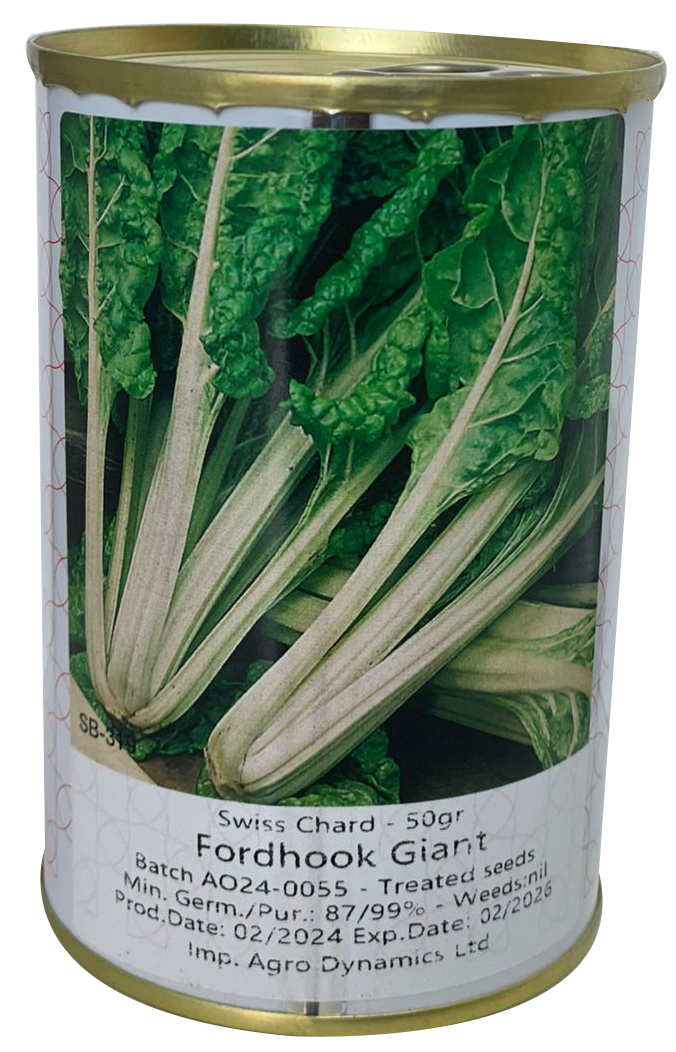- [email protected]
- +256 200 947136
Vegetable seeds
Copenhagen Cabbages
Copenhagen cabbages are a good early maturing variety that produces uniform, globe shaped 6’’ diameter heads that are firm and solid
Characteristics
- A well-adapted cabbage with an exceptional
- Maturity 65days from transplanting
- Head weight 5kg-3KGS
- Yield potential 30-35 tonnes per acre
- Early maturing and low crop protection cost
- Dark green in colour with a brighter heart
- Firm and round heads good for long distance transportation
- Spacing: 60cm*60cm or 60cm*45cm
- Rate: 75g per acre
Cultivation Advice:
- Start seed indoors or in greenhouse in early spring (5-7 weeks before planting outdoors).
- Or plant directly outdoors in mid spring or early summer when last frost has passed.
- Sow 2-3 seeds together every 12-18
- Planting depth 1/8
- When seedlings are 1 inch tall thin to one plant every 12-18
- Plant cabbage in a sunny location where no cabbage was grown the year before.
- Keep weed free, moist and protect against

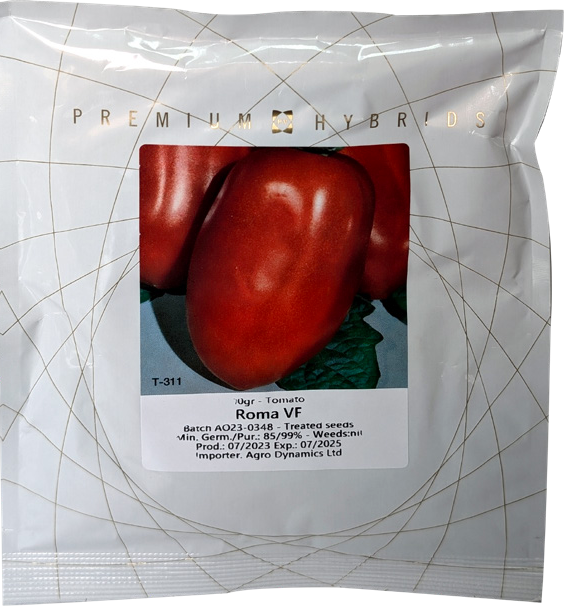

Tomato Roma Vf
Roma VF tomato seeds are open pollinated tomato seeds produced by Pop Vriend Seeds Company. Roma tomato seeds can be used for the production of tomato paste. It is also an excellent fresh market tomato cultivar.
Roma VF tomato seeds, though an open pollinated variety, it is resistant to Fusarium Wilt and Verticillium Wilt. This variety matures in 75 – 95days.
Planting guide
- Start seeds from nursery 6-8
- Use a seed starting mix g. cocopeat and plant seeds 1/4 inch deep in trays or pots.
- Keep soil moist and provide plenty of light. Seedlings emerge in 5-12 days.
- Transplant outdoors after hardening off when night temps stay above 50 F. Add compost to planting holes. Space 18-36 inches apart.
- Use cages, stakes, or trellises to support plants as they grow. Mulch around bases.
- Water 1-2 inches per week. Feed with organic fertilizer when fruits start forming.
- Roma VF tomatoes are typically ready to harvest 70-80 days after transplanting. To harvest, simply cut the fruit from the vine with a sharp knife.
- Harvest tomatoes when fully colored but still firm. Enjoy!
Product Features
- Colour: Red tomato fruits
- Shape: Big and round shaped tomato
- Plant Quality: Hardy and rugged
- Time to Maturity: 75 -95 days after transplanting
- Growth Habit: Determinate
- Weight of Fruit: 90 – 120 g
- Disease Resistances: Fusarium Wilt, Verticillium Wilt, nematode and TMV (Tomato Mosaic Virus).
Tomato Rio Grande
Rio-Grande is an open-pollinated tomato variety with oval fruits suitable for all markets. This variety offers a perfect balance between firmness and juice content making it suitable for a variety of uses
Characteristics
- Determinate variety (has definite flowering and fruiting).
- Matures in 75 -80 days from
- Fruits weigh on average 90 – 100
- Yield potential 12-16 tonnes per acre
- Very good shelf life and easy to transport long distances with minimal losses.
- Very fast at germinating with vigorous
- Fruits mature at the same time and thus can be harvested at once.
- Well adapted to hot days and cold nights (withstands extremes in temperature).
Cultivation Advice Tomato Rio Grande
- Sow in spring 1/16 inch
- Germination takes around 6-14 days at 65-
- Transplant the seedlings when large enough to handle into 3inch pots.
- Grow on under cooler conditions and when about 8 inches tall,
- Either plant in their growing position in the greenhouse
- Or gradually acclimatise them to outdoor conditions
- And plant out 18 inches apart in a warm and sunny spot in moist, Fertile well drained soil and keep watered
Resistances / Tolerances
- Good tolerance against Leaf Roll
- Resistant to Verticillium and Fusarium
Spacing: 35 cm x 100 cm.
Seed rate: 400 grams per acre (direct seeding) OR 80-100g per acre (transplanted).
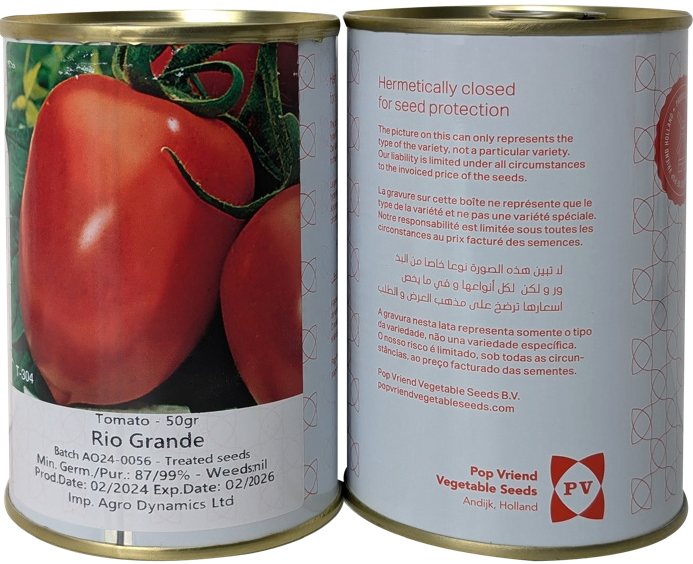

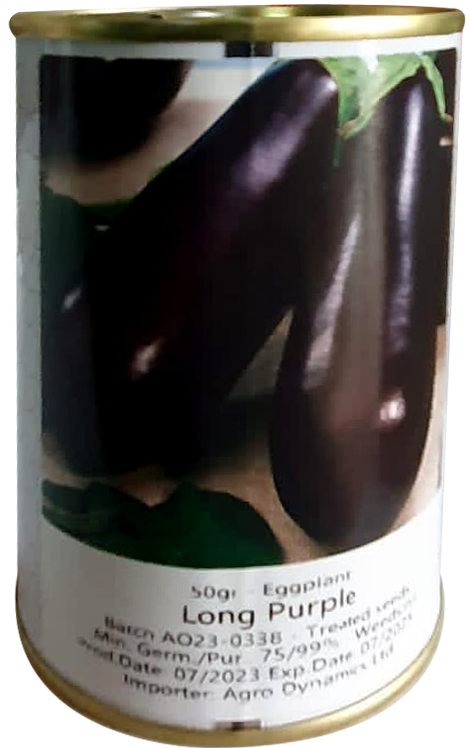
Eggplant Long Purple
Long Purple eggplant is a popular early-producing open pollinated variety that gives gardeners a good yield of 8–10” long, narrow, deep-purple-coloured fruits with mild and delicious white flesh and few seeds.
Special attributes
- Vigorous and high yielding eggplant
- Oblong shaped with purple-coloured
- Tall and
- Yields 8-10 fruits per
- Maturity is 70-85 days
- Harvest is 70-150days
- Soil types for long purple are loamy and sandy
Gardening tips
- Seed rate/acre 100g
- Spacing 60cm x 75cm
Egg Plant Black Beauty
Eggplant black beauty is open pollinated variety that matures in 60-70 days and its dark purple and round 8-10cm in diameter. The flesh is firm and mild in flavor and its lovely when cooked.
This eggplant will thrive in diverse weather conditions and it can even be grown in pots at the backyard in urban settings
Cultivation advice:
- Sow in 2 seeds per pot in early spring covering lightly with fine soil, and ensure a minimum temp of 70F until
- When 3 – 4 inches high plant to growing position, (ground / 9in pot or 3 per grow bag), best under
- These will not tolerate cold
- Provide support and keep pest
- To aid fruit development, add potassium rich fertilizer with each watering when fruit has
- To encourage further production, pick before the fruit surface shine
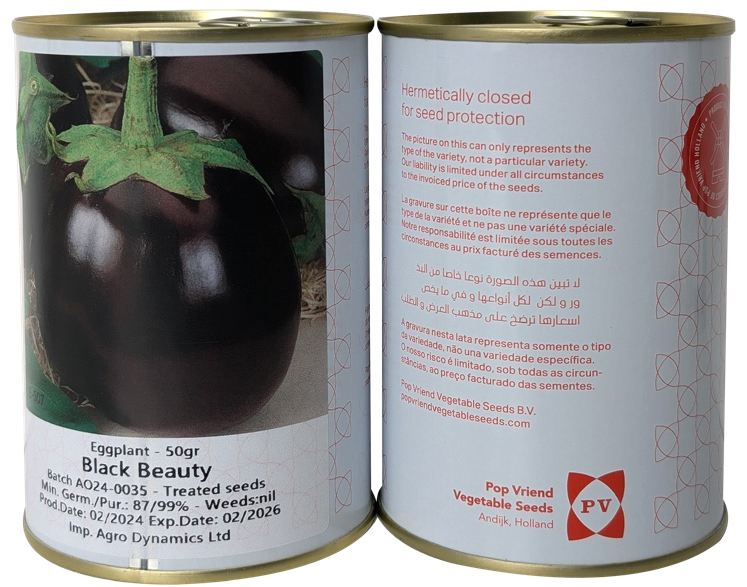

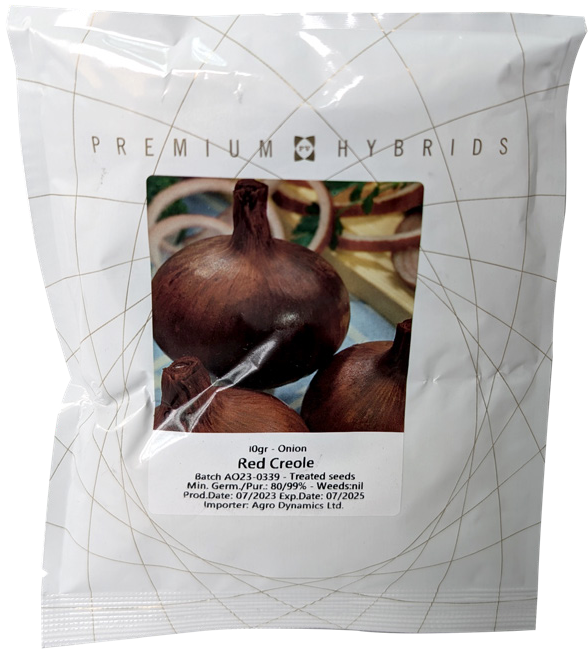

Onion Red Creole
Red Creole is a medium maturing, open-pollinated short day red onion. Red Creole is well adapted and very widely planted. The outer scale is dark red; the rings are tight and red right through to the centre of the bulb. The bulbs taste slightly pungent, are firm, with a granex shape. The bulbs are attractive and store well.
Characteristics Of Red Creole
- A thick flat to flat round bulb with a moderate firmness
- Exterior color of bulb is bright red to bronzy
- Interior colour of bulb is white with red inner scales
- Plant has thin and fairly loose outer scales with a medium basal plate and neck size
- Color of plant leaves is medium blue-green
- Average maturity: 210 – 220 days
- Well adapted with a good yield and store well
Planting Guide
- Planting distances within row should be 5-
- Planting distances between rows should be 30-
- The average planting Depth should be 5cm.
- Optimum pH is around 0 to 6.8.
- The preferred soil type is free-draining friable
Crop rotation is necessary
Onion Red Bombay
Bombay red is an excellent pungent red onion with high market demand. The onion matures in 150 days from transplanting and is very popular with red onion farmers. The yield potential 16tonnes per acre at maximum when good management is taken into practice. The onion has an excellent shelf life and can be transplanted long distances without damage
Nursery Establishment
- All onions are raised on a nursery bed before being transplanted onto the main seedbed once 1acre requires an average of 1-1.8kgs of seed depending on the variety and irrigation method used.
- The plot should be prepared by digging and mixing the soil with well decomposed farmyard
- For ease of nursery management practices such as weeding and irrigation, ensure thenursery bed is 1.2m wide and of a conventional length.
- Make shallow drills of 1cm – 2cm depth at a spacing of 15cm – 20cm apart. Thinly sow the seeds and cover them lightly using soil or well decomposed and fine farmyard manure.
- At this point you can drench your nursery using a bio-stimulant, fungicide and insecticide to control against early attack of soil borne diseases and pests.
- Germination takes place in about 5-
- Depending on environmental conditions, irrigate your nursery in the morning hours but maintain a damp condition during the 6weeks of seed raising in the nursery.
- On the 6th week when seedlings have 3-5 leaves trim them and apply a fungicide to prevent attacks from Downey mildew. This facilitates more root development, more plant vigor and large
- Seedlings are ready for transplanting when they have 3-5 well formed leaves
- Before lifting the seedlings, the nursery bed should be irrigated a day before to avoid root damage of the seedlings.
- The seedlings should be transplanted in rows 15-20cm apart and 8-10cm from one seedling to the At this spacing, the onions utilize fertilizer and manure applied efficiently which in turn makes onions mature fast and maximize yield per unit area. NOTE: During transplanting, don’t burry the onion seedlings more than 1inch into the soil.
Nutritional Requirement
- At planting, application of phosphorous is crucial as this acts a starter solution that invigorates young seedlings growth. One can choose to apply NPK or CAN. o After 2-3weeks when the seedlings have established, a top dress using a nitrogenous fertilizer is A second and third top dress split might be necessary depending on the soil analysis results
- Foliar fertilizers can be applied in between the basal fertilization splits to maximize on nutrition required during
- Once the bulbs start to form and push away the soils, minimize on Nitrogen application as this can lead to delayed maturity due to thick necks and soft o Since onions develop slower than other vegetable crops, they are more susceptible to weed competition especially during early stages of growth which can result to yield losses.
- Weeds can be controlled by using pre or post emergence herbicides by using only registered products. Care should be taken to avoid damage to the bulbs when carrying out mechanical weeding.
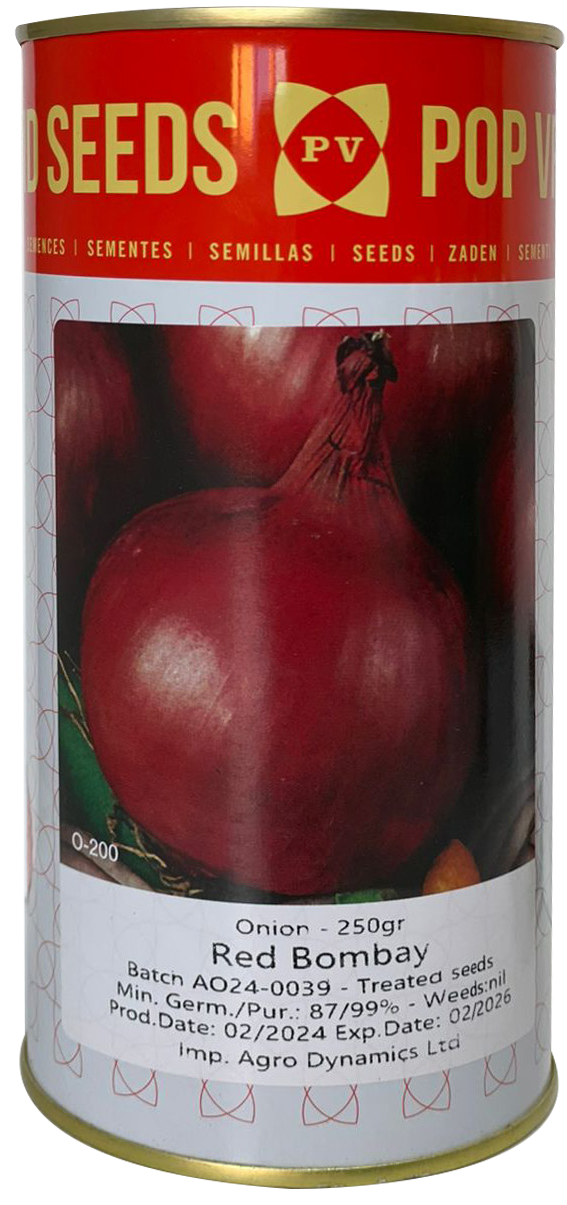



Onion Texas Grano
Texas Grano is a medium to late maturing short day brown onion with intermediate pink root (Pt) resistance. The bulbs are uniform and have a granex shape. The scales are yellow, delicate and smooth. Texas Grano is well suited for early sowings in areas with a mild incidence of pink root. Bulbs produced from transplants are much rounder than direct seeded bulbs.
Texas Grano is a very high yielder and the bulbs have a refined neck. Texas Grano is suitable for most soil types.
Planting information:
General Sowing Time: | Year Round |
Position: | Sun |
Sow Depth: | 3 mm |
Spacing: | 5 x 20 cm |
Germination: | 7-14 days |
Days to Harvest: | 180 – 240 days |
Temperature: | 15 – 20° C |
Watermelon Crimson Sweet
Watermelon Crimson Sweet. A very productive variety producing large round melons averaging 20-25 lbs which are oval, light green with dark green stripes. The fruit has very sweet flesh that is brilliant red and practically seedless. Good disease resistance. Ready for harvest about 85 days after seeding in warm conditions. Can be grown outside in a warm, sheltered and sunny location, but for the most reliable crops under glass is best.
Cultivation Advice Watermelon Crimson Sweet
Type: | Annual |
Temperature Required: | 20 – 25 c |
Time to Germinate: | 5 -10 Days |
Days to Maturity: | 60-90 Days |
Position/ Light: | Full Sun and sheltered Location |
- Prepare soil by digging and incorporating liberal amounts of well-rotted compost or farmyard manure over-winter.
- Watermelons thrive in a sunny, warm location
- Keep at a temperature of around 20-25C (68- 77F) until after germination, usually 5-7 days.
- When first true leaves develop, transplant into 13cm (5in) pots for a few
- Plant out 24 inches apart after carefully hardening off after all risk of frost in a warm sheltered position in full sun or for a more reliable crop under glass.
- Water regularly and feed with liquid fertilizer every 14 days.
- Pinch out growing point at the 4leaf stage and train the laterals (side-shoots) along the row. Hand pollinate if required.
- At harvest time, tap the watermelon with your knuckles, and if it sounds hollow, it’s ripe
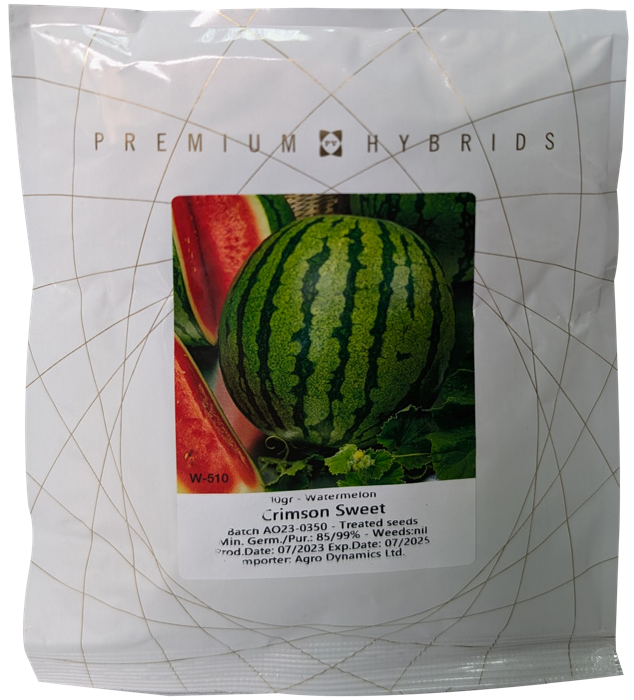

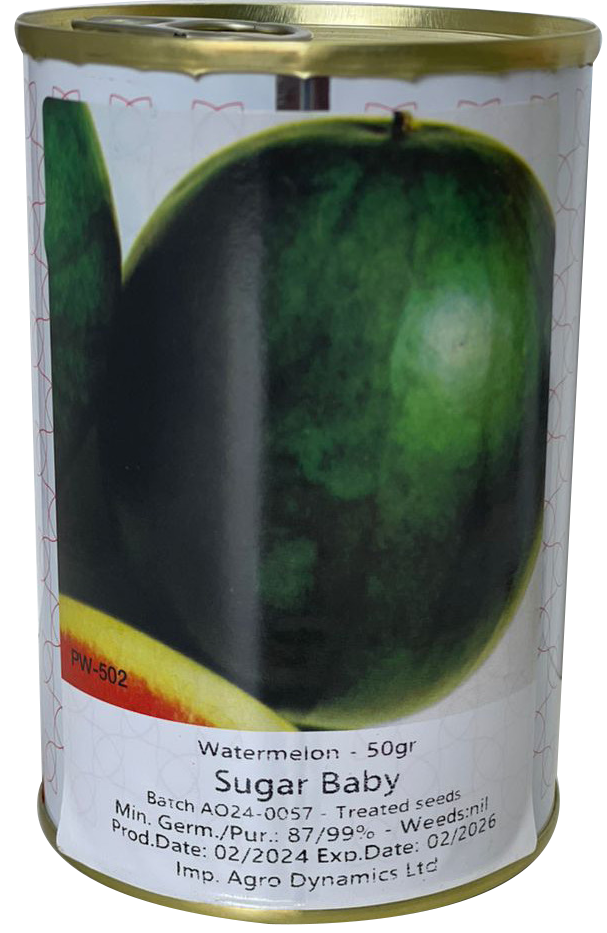

Watermelon Sugar Baby
Water Melon Sugar Babe. Sweet tasting and smaller fruited “Ice Box” type watermelon. Early and very productive with sweet, juicy, fine- textured, medium-red flesh and thin hard rind. The round, 8 to 12 lb, dark green skinned melons grow 8 inches across. Ideal variety if space is limited, as this can be trailed on trellises and faster to ripen in short summers. Drought Resistant. Ready to harvest about 75 days after seeding in favourable conditions. Can be grown outside in a warm, sheltered and sunny location, but for the most reliable crops under glass is best.
Cultivation advice Water Melon Sugar Baby
Days to Germination: | 5-7 |
Days To Harvest: | 75 in warm conditions |
Planting Depth: | 1/2 to 1 inch |
Spacing: 2 feet | 2 feet |
Light: | Sunny, Warm, Sheltered Location |
- Prepare soil by digging and incorporating liberal amounts of well-rotted compost or farmyard manure over-winter. Watermelons thrive in a sunny, warm location
- Sow April to May 1cm (½in) deep, in 7cm (3.5in) pots of free-draining seed sowing mix. Place in a (propagator, airing cupboard) and keep at a temperature of around 20-25C (68-77F) until after germination, usually 5-7 days.
- When first true leaves develop, transplant into 13cm (5in) pots for a few
- Plant out 24 inches apart after carefully hardening off after all risk of frost in a warm sheltered position in full sun or for a more reliable crop under glass.
- Water regularly and feed with liquid fertilizer every 14 days.
- Pinch out growing point at the 4 leaf stage and train the laterals (side-shoots) along the row. Hand pollinate if required.
- At harvest time, tap the watermelon with your knuckles, and if it sounds hollow, it’s ripe
Watermelon Crimson Sweet
Watermelon Crimson Sweet. A very productive variety producing large round melons averaging 20-25 lbs which are oval, light green with dark green stripes. The fruit has very sweet flesh that is brilliant red and practically seedless. Good disease resistance. Ready for harvest about 85 days after seeding in warm conditions. Can be grown outside in a warm, sheltered and sunny location, but for the most reliable crops under glass is best.
Cultivation Advice Watermelon Crimson Sweet
Type: | Annual |
Temperature Required: | 20 – 25 c |
Time to Germinate: | 5 -10 Days |
Days to Maturity: | 60-90 Days |
Position/ Light: | Full Sun and sheltered Location |
- Prepare soil by digging and incorporating liberal amounts of well-rotted compost or farmyard manure over-winter.
- Watermelons thrive in a sunny, warm location
- Keep at a temperature of around 20-25C (68- 77F) until after germination, usually 5-7 days.
- When first true leaves develop, transplant into 13cm (5in) pots for a few
- Plant out 24 inches apart after carefully hardening off after all risk of frost in a warm sheltered position in full sun or for a more reliable crop under glass.
- Water regularly and feed with liquid fertilizer every 14 days.
- Pinch out growing point at the 4leaf stage and train the laterals (side-shoots) along the row. Hand pollinate if required.
- At harvest time, tap the watermelon with your knuckles, and if it sounds hollow, it’s ripe


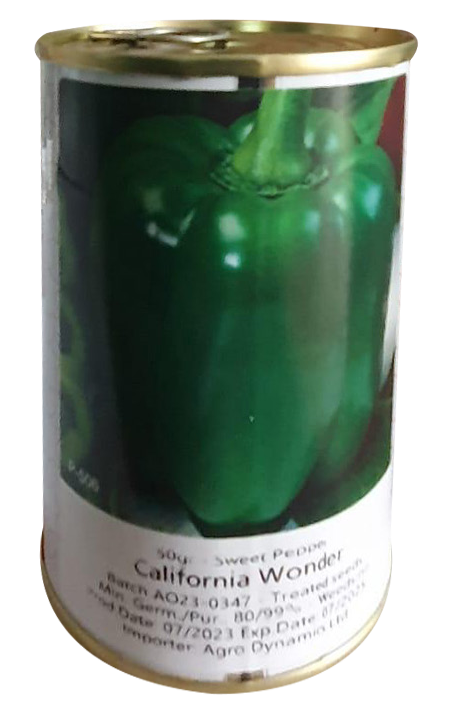

Sweet Pepper Cali Wonder
The California Wonder pepper is a standard bell pepper that is widely adapted. These pepper plants produce very sturdy frames that are easy to grow. This pepper always produces well formed, juicy, crunchy, large pepper fruits.
The California Wonder contains high amounts of vitamin A and C and is disease resistant to tobacco mosaic virus. This pepper variety is very popular, and much preferred by many market growers and home gardeners!
Product Details-
Variety: Open Pollinated
Pepper type: Sweet
Plant type: Medium strong bush
Fruit Shape: Blocky, Bell shaped
Size: 10 x 9 cm
Maturity time: Mid early
Fruit Colour: Green turning Red
Maturity days: 70 t0 75 days
Growing Tips:
- Sow in the greenhouse 7-9 weeks before the desired planting date.
- Allow plants to harden 7 days before transplanting.
- Plant transplants halfway between root ball and bottom This will help prevent lodging.
- Scout every 7 days to ensure crop
- Cut or break pepper off the plant but leave at least 1” of the stem attached to the pepper.
- Clean and wax
Beetroot Detroit Dark Red
Detroit red Beetroot is an excellent standard open pollinated variety (OP), well adapted prolific producer with good heat tolerance.
This plant matures in 65-75days from planting and forms a globe shape with a uniform dark red flesh on cutting open at a spacing of 10cm*25cm, when using about 3,200g per acre, the anticipated yield is 8,000-10,000 kg/acre.
Characteristics:
A prolific producer with good heat tolerance | |
Fruit shape globe | |
Fruit colour: | Uniform dark red |
Maturity: | 65-75days from transplanting. |
Spacing: | 10cm*25cm |
Seed rate: | 3,200 grams per acre direct planting |
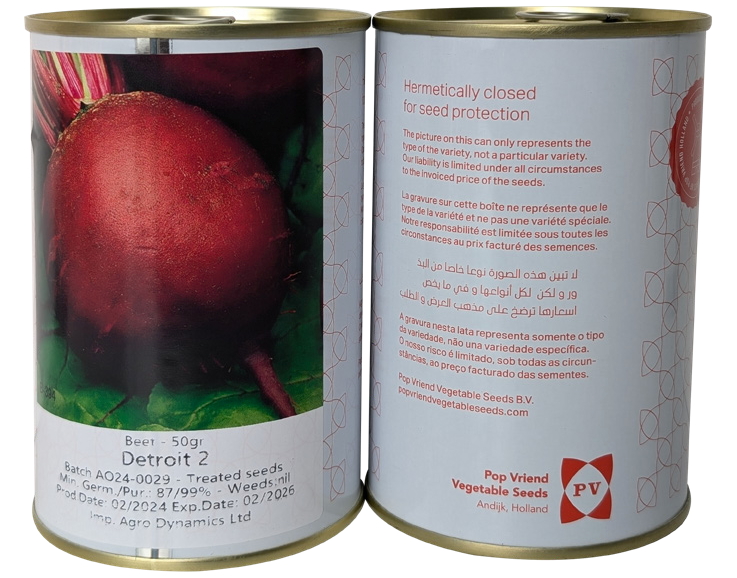



Cauliflower Snowball
Snowball is a white cauliflower with a great taste for incorporation in a variety of Western and African dishes. The plant produces round, firm heads weighing about 1kg when mature (80-85) days and large green outer leaves. The yield is estimated at 10,000-12,000kg/acre at a spacing of 30*30cm using 400g of planting material. This plant can be started from the nursery and transplanted at 5-8 true leaves.
Characteristics:
White, round and firm head. | |
Weighs about 1kg when mature | |
Large green outer leaves | |
Maturity: | 80-85days |
Yield potential: | 10,000-12,000kg/acre. |
Planting guide:
- Spacing: 30cm *30cm
- Seed rate: 400 grams per acre direct seeding or 120 grams per acre
Carrot Nantes
Nantes is a long straight tasty carrot variety with a very attractive internal flesh with high vitamin A content. The carrots are cylindrical, straight with a rounded tip and matures in 110 days from planting measuring 17-20cm long.
This particular variety yields about 17tonnes per acre with a good management system in place and carrots are deep orange in colour. It also exhibits partial tolerance to powdery mildew
Cultivation advice Seed Tape Carrot Nantes 6M (3X2M)
- Sow Apr to Jun direct to the growing
- Prepare the soil in your chosen growing location, removing any weeds and raking to a fine
- Make a shallow drill in the soil and simply roll out the tape in the Tape can be cut to suit row length.
- Cover thinly with soil, water lightly, mark the row with a label and ensure the soil is kept
- The seed is pre-spaced on the tape; however, you may need to do a small amount of thinning on some varieties as they develop depending on the germination rate achieved.
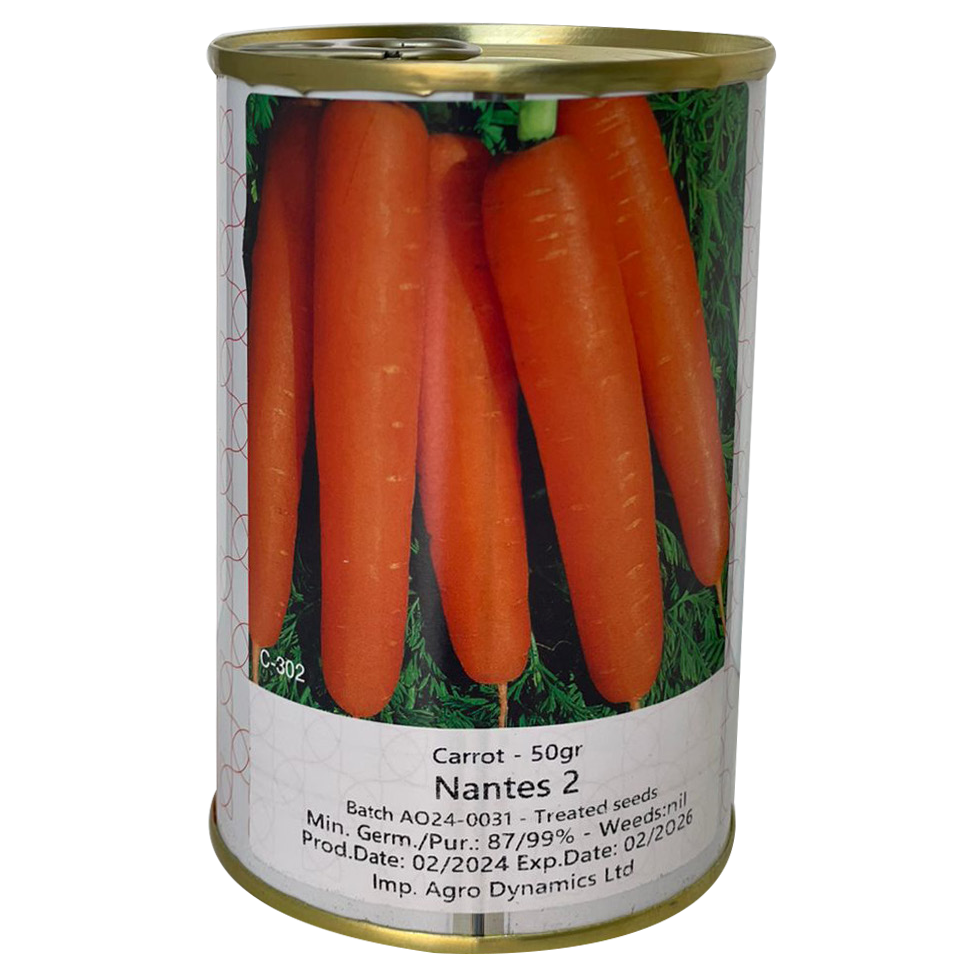
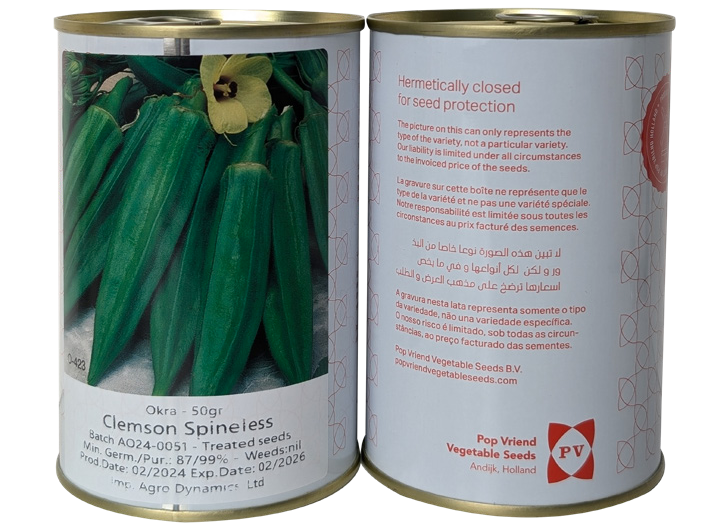

Okra Clemson
Parsley is an aromatic plant with an erect growth habit and possesses branched, hollow stems and dark green flat or curled leaves which are arranged alternately on the stems.
It is a high-quality hybrid seed. Belongs to varieties that stand out with incredible productivity and flavour of their leaves. Parsley is a biennial herbaceous plant and reaches stature heights between 30cm and 100 cm.
Planting guide:
The plant produces small, yellow flowers on
Germination is very slow, but if you soak the seed overnight in
Cover the seeds with soil and mark the rows since germination is so The growing parsley seeds look like fine blades of grass.
Keep the plants consistently moist as they continue to grow, fertilize the plants once or twice during their growing season with a 5-10-5 Your growing parsley seeds should be ready for harvest as soon as they are a few inches tall, can reach 30–100 cm in height depending on the variety.
Just snip the outer stems from the plant and it will continue to grow throughout the
Parsley Mosscurl
Parsley mosscurl is a very productive plant that grows to 10-12 inches high and produce a dense cushion of finely cut, deeply curled leaves that are dark green with a strong aroma and flavour.
It is equally adaptable to growing indoors or outdoors and can be harvested continually during growing season.
Planting Advice:
Days To Maturity: 70
Days To Germinate: 18-24
Planting Depth: 1/8 to 1/4 inch
Spacing, Row: 16-18 inches
Spacing, Plant: 6 inches
Light: Full Sun or Partial Shade
Sow seed thinly directly outdoors from mid spring onwards in a sheltered position as soon as soil is workable and cover with 1/8 to 1/4 inch fine To speed germination, seed can be soaked in warm water for 24 hours before planting.
Plant on a windowsill throughout the
Thin outdoor plants to 6 inches apart when seedlings are 2 inches Indoor windowsill pots can be left to pick young as does not transplant well.
Harvest leaves continually during the growing season to encourage new Harvest larger sprigs off plants as they mature.
Parsley grows best in a mostly sunny location with relatively rich, moist, well drained soil
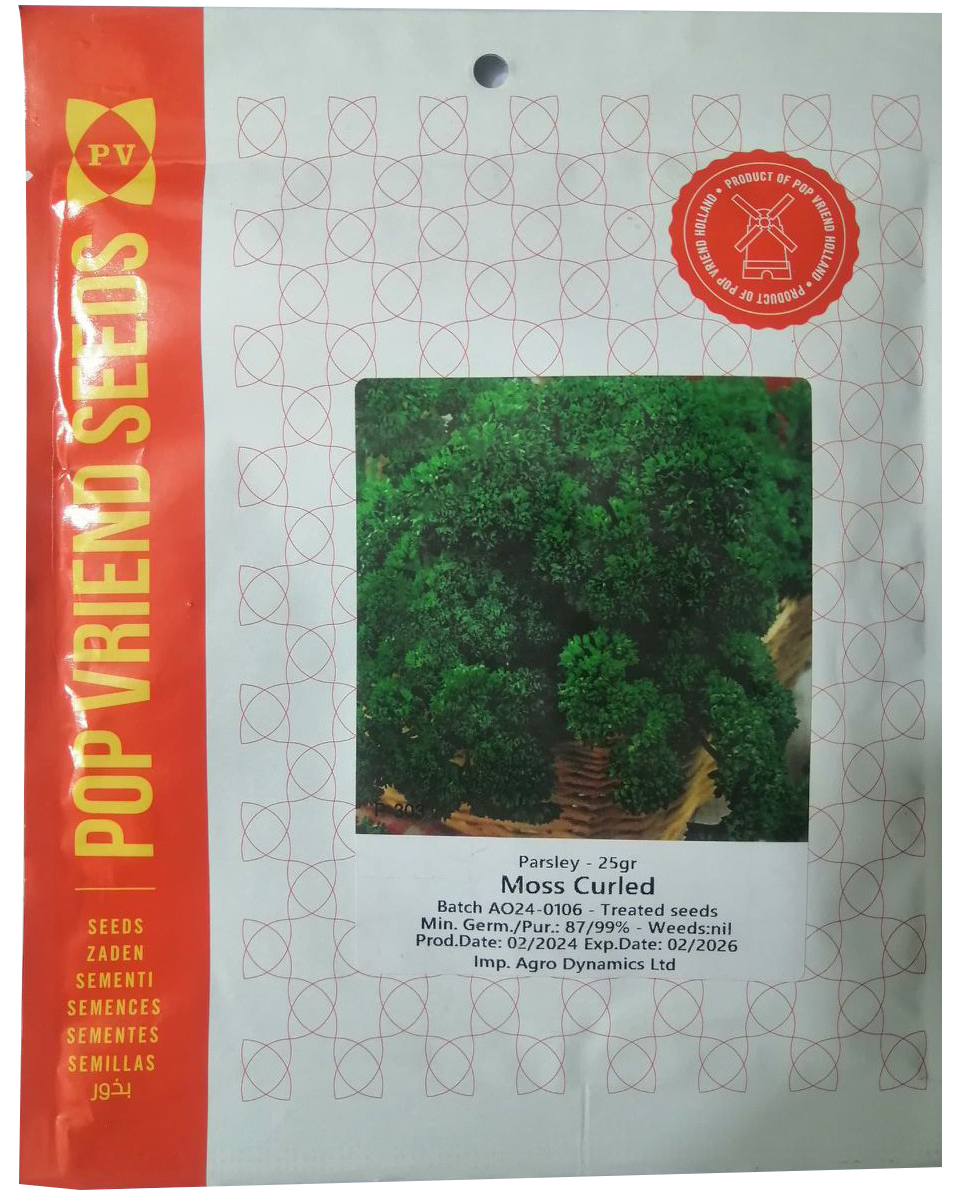
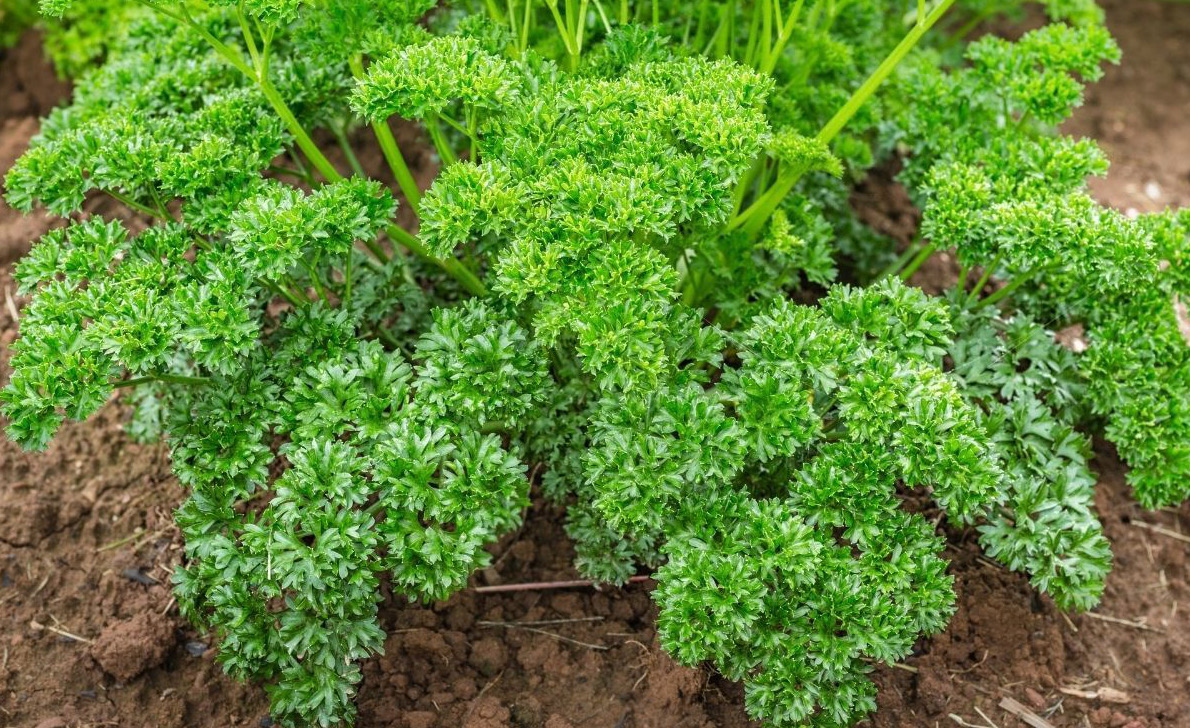
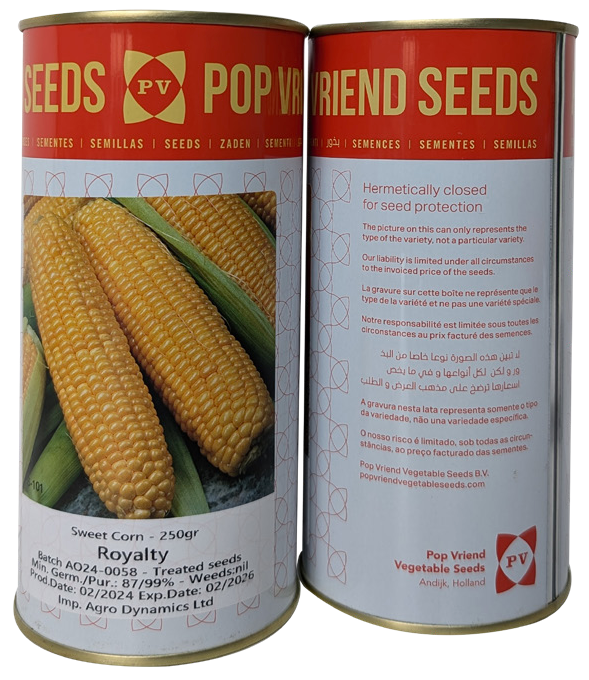

Sweet Corn Royalty
Sweet corn royalty is a medium-sized, high yielding, disease resistant, hybrid seed.
The ears are very thick and heavy. Tip: For fresh consumption, boil the ears for only 10 minutes! It differs from feed maize in that it has thinner leaves, a much higher sugar content in the kernels and a slower conversion to starch
Features:
- Plant height: 195 cm
- Ear height: 70 cm
- Cob length: 20 cm
- Cob colour: Golden yellow
- Maturity days: 55 days
- Tolerances: Stewarts Wilt, Northern Corn Leaf Blight and Southern Corn Leaf Blight
Planting Advice:
- Grow sweet corn in a spot that receives plenty of sunshine, in soil enriched with a lot of well-rotted organic matter.
- Seeds may be sown directly outside once the soil has warmed up, the safest way to sow is into pots or trays,
- Sowing two seeds to each module, 1 inch deep then removing the weakest of the two seedlings. They should germinate in 7 to 10 days.
- Corn should be about 15 cm tall by the time you’re ready to plant them outside. Harden off the plants by leaving them outside for about a week.
- Use a balanced fertilizer, spread evenly, and work it into the soil 3 to 4 inches deep.
- Sweet corn is wind-pollinated, so instead of planting in a long row, set your plants out in a block for the highest chance of success. If the corn isn’t well pollinated, it will be missing many of the kernels from the cob.
- Try to retain as much of the soil around the roots when transplanting. Plant sweet corn 18 cm apart in both directions.
- Remove any weeds that pop up within your sweetcorn by hand and continue while you are still able to get between the plants
- It appreciates watering in dry weather, as the silks appear and the cobs begin to form.
- The cobs are ready to pick when the tassels at the end turn dark brown, usually around six weeks after first appearing.
Swisschard Fordhook Giant
Swiss Chard Fordhook Giant has gorgeous dark savoy green leaves with vibrant ivory stalks & veins that brighten up your veg patch, your dinner plate & maybe your flower beds too! Despite its size, it is a very easy to grow vegetable.
- The flavorsome leaves are thick and tender, making an appealing steamed vegetable or a colourful addition to stir fries. Swiss Chard ‘Fordhook Giant’ is a well-established variety from the 1920’s and remains popular today.
- As the name suggests, this monster Swiss Chard grows up 60cm tall, making an impressive display on the vegetable plot, or even in your flower borders. Height: 60cm. Spread: 50cm.
- The colourful leaves & stems can be picked whilst young (in 32 days) as baby leaves and used raw in salads or left to grow on and used in stir-fries or sauteed in butter (and it keeps it’s colour when cooked!)
Planting advice:
When to Sow March to August, but best in March or July/August.
How to Sow: Either indoors in modules/small pots with 1-2 seeds per unit and remove the weaker seedlings. Transplant out when large enough in spring spacing 15-25cm apart. Or direct sow thinly once the soil has warmed up in April-July into drills
2.5cm deep by 30cm.
Care: They must be kept watered in summer to prevent bolting, but if some do start to bolt just cut down the middle stem and give them a good water. Keep picking leaves to encourage new ones, and during winter take off old ones before they begin to rot & affect other leaves. Chard is not hardy but is tough enough to survive most winters, just cut off any mushy leaves and it will begin to re-grow when the weather warms up.
Harvest: 10 weeks after sowing, March ones will be ready late May onwards & August sowings will be October onwards. It is a biennial so will last 2 seasons.
